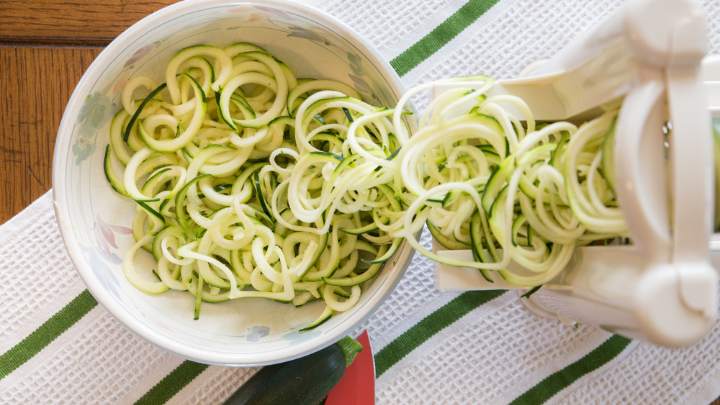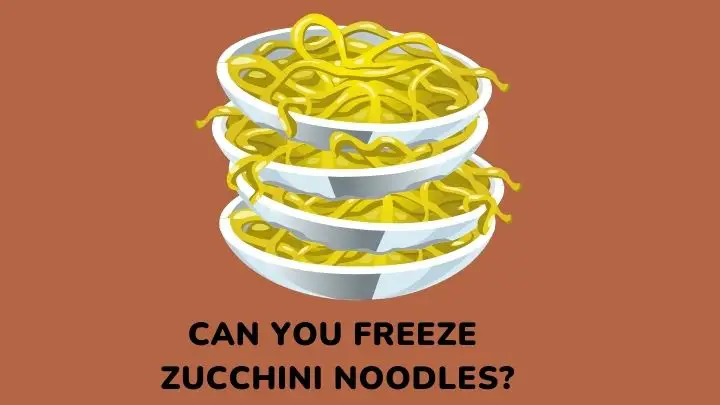Wondering if you freeze that excess zucchini noodles? Yes, you can! But not without a few buts here and there. Zoodles are fast becoming famous. All thanks to the urgent need for vegan, gluten-free, and low-carb meals.
If zucchini noodles have taken over your instant noodles, you need to learn the preservation and storage hacks I’ll be sharing in this article. Ending up with more food than you need happens to anyone. What makes it better is preventing waste.
Also, making zucchini noodles from scratch is always time-consuming. Once you master these hacks, you will have zucchini instant noodles in no time.
So, if you want to learn how to freeze zucchini noodles for later, continue reading.
What are zucchini noodles?

Zucchini noodles or zoodles are zucchini cut into spiral strips using a spiralizer. Zoodles look like spaghetti except for their green and white colors, until you have a taste anyway.
They are healthy alternatives to regular pasta because they are low in carbs and high in nutrients. Moreover, plain zoodles are not made with wheat flour, so they are perfect for a gluten-free diet as long as you cook them with gluten-free ingredients.
Zoodles are commonly served with pesto and romaine salad. But you can eat it in several other ways.
Can you freeze zucchini noodles?
Yes, you can freeze zucchini noodles for use later. Freezing zoodles helps to keep them for months, maybe up to a year. It also preserves the nutrients and texture of the zucchini for at least 4 to 6 months.
While freezing zucchini noodles is a good idea, it is not a very easy procedure. There is a lot you need to put in place before tossing the bag of zoodles into the freezer. There are measures to put in place to preserve texture and nutrients in zucchini, like blanching.
Blanching zoodles before freezing slows the activity of the enzymes that cause zucchini to lose flavor and become mushy.
Can you freeze zucchini noodles without blanching?
If you will need the zucchini noodles within a few days, you can freeze it without blanching it. Blanching is good for zoodles you plan to store for weeks or months.
If you will not be blanching your zoodles, dry them properly and gather them into a freezer bag. Squeeze out as much air as you can, seal the bag, and place it in the coldest region of the freezer.
How long do zucchini noodles last in the freezer?
If you store them properly and in the best conditions, zucchini noodles can last up to one year in the freezer. Keep the freezer on and do not open the door of the freezer too frequently to keep the temperature stable.
How to freeze zucchini noodles
Prepare the zucchini
You will get the best out of freezing if you work with fresh food items. Ensure you are freezing fresh zucchini without blemishes. If there are any, cut them if they are negligible. Wash the zucchini to remove any dirt and soil.
Afterward, use a knife to remove the ends and cut the zucchini into sizes you can handle with the spiralizer. Scoop out the seeds and rinse again if necessary. Use the spiralizer to turn the zucchini into zoodles and set it aside.
Blanching or dehydrating
This stage is very important to the texture of your zoodles while it freezes. Blanching or dehydrating with salt helps to maintain the texture of your zoodles and retain their nutrients.
If you freeze zucchini noodles without any of these procedures, the moistness will make them lose their shape and texture resulting in a soggy mess.
If you are blanching, you will need a pot of hot water and a bowl of ice. You can leave the zucchini noodles in the strainer and put them together in the hot water for 60 seconds.
Pour the halfway cooked zoodles over the ice immediately after you bring out the strainer, to stop the cooking process.
The dehydrating method is the most common. This method uses salt to remove water from zoodles. Use ½ tablespoon of salt (preferably kosher salt) for every 2 cups of zoodles. Sprinkle the salt over the zoodles and massage it in with your hands.
While you do this, you will see moisture seep out of the zoodles. Continue doing so until you feel the zoodles firm up in your hands and the water becomes slightly soapy with small bubbles on the body of the noodles.
Afterward, line a colander with a towel or cheesecloth and pour the zoodles into it. Gently squeeze out the water. Squeeze until there is no more liquid running. Spread clean paper towels on the kitchen counter and spread the zoodles on them in a single layer.
Leave the zoodles to dry for about an hour. You can do this drying method for blanched zoodles too. The drier the zoodles, the better your chances with the texture.
Packaging
You can move on to the packaging stage once your zoodles contain almost no moisture. If you have many freezer bags, share the zoodles in small portions to make thawing easier. With small portions of zoodles, you won’t have to thaw what you do not need.
Transfer the dry zoodles into the freezer bags (make sure they are thick). Release as much air as you can from the bags and seal. Label the bags with the date of freezing so you can keep track.
Freezing
Finally, you can now freeze your bags of zucchini noodles. Put them at the back of the freezer where it is coldest.
It is advised that you do not open the freezer door too frequently or leave it open for long. Not just for the zoodles but for every other food item you have in there.
Temperature fluctuations in the freezer can cause ice recrystallization which can negatively affect the texture and flavor of the food items.
How to thaw zucchini noodles
Take out the frozen zoodles and allow them to thaw overnight in the refrigerator or for a few hours on the kitchen counter. Drain the excess water using a strainer.
Boil water in a pot, place the strainer with zoodles into the hot water, and allow it to heat up for a few minutes.
You can also make a stir-fry immediately after draining off the excess water. Sauté the noodles on medium heat in hot oil and veggies in a skillet.

How do you know zucchini noodles have gone bad?
You need your eyes, nose, and sense of touch to identify rotten zoodles. First, how long have you kept the bag of noodles? If you’ve had it in the refrigerator longer than seven days, it is most likely bad and you should trash it already.
Bring out the bag of zoodles from the refrigerator or freezer and touch it. If the zoodles were frozen, allow it to thaw before examining it. If the noodles feel rubbery or slimy, they are rotten and best for trash.
Other signs to look out for are a sour smell, mold growth, dark spots, and discoloration that wasn’t there before. If you still have doubts about the condition of your zoodles, take a little bite. If it tastes saltier than usual, the zoodles are rotten and may be harmful if you eat them.
Pros of freezing zucchini noodles
- It saves cooking time
- Freezing zucchini noodles prevents waste
- Freezing helps to lock in nutrition
Cons of freezing zucchini noodles
- Frozen zoodles are not as flavorful as fresh zoodles
- If you do not check your freezer thoroughly and often, you can forget about the bag of zoodles, which eventually leads to the waste you were avoiding
FAQs
Is freezing the best way to store zucchini noodles?
Freezing is the best way to zucchini noodles, especially if you are looking at long-term storage.
Your zoodles will remain fresh but a bit less flavorful. You can make up for this loss of flavor by serving it with fresh and tasty pesto or any other side you have in mind.
Can you refreeze zucchini noodles?
Yes, you can refreeze zucchini noodles if you have not tossed them with sauce or cream.
Plain zoodles are the best for refreezing because you will lose nothing except the texture. Dry the thawed zoodles with a paper towel, leave them to dry well, and put them into a thick freezer bag.
If you have tossed the zoodles in sauce, refreezing it will not be a good idea. Naturally, freezing makes the sauce separate into crumbs and imparts the taste. Refreezing zoodles after thawing them wastes the meal because it will become unappetizing.
How long can you leave zucchini noodles out?
Room temperature is not a good place to store zucchini noodles. Whether raw or cooked, pack the zoodles and refrigerate or freeze them. Refrigerating zoodles will keep them for 3 to 4 days while freezing is for long-term storage.
Conclusion
Now you have these hacks. When next you have a full harvest of zucchini from your backyard garden or the stores, make a lot of zoodles. This way you can quickly satisfy your cravings without burning time and energy.
Freezing zucchini noodles prevents waste and cuts down on cooking time. Moreover, it allows you to have zucchini on hand for your soups and salads. If you thawed more zucchini than you need, no worries. Allow the thawed zoodles to dry and put them in a thick freezer.
However, remember that your zoodles will not be as firm and crunchy as they were before freezing. Also, freezing zoodles for too long will compromise their texture. If you do not mind this, you are good to go.
Looking for a way to preserve green onions for later? See how you can freeze scallions and keep them fresh for later use.
Thanks for reading.

